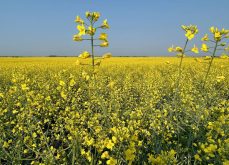MarketsFarm — ICE Futures’ canola market saw some independent strength relative to other oilseeds during the week ended Wednesday, as speculative positioning and the need to ration tight old-crop supplies provided support.
Canadian canola stocks as of March 31 were pegged at 5.95 million tonnes by Statistics Canada in a report released Tuesday. That was up from 5.16 million at the same time the previous year, but well below the five-year average of 8.76 million. Of the total, commercial stocks of 1.28 million tonnes were down by about 460,000 tonnes from the same point the previous year and below pre-report expectations.
Read Also

Record large Canadian wheat and canola crops: Statistics Canada
Canadian wheat and canola production in 2025/26 (Aug/Jul) surpassed early expectations to hit new record highs, according to updated survey-based estimates from Statistics Canada released Dec. 4.
“It appears that supplies will be quite a bit tighter going into the new crop,” said Ken Ball of PI Financial in Winnipeg. He questioned why the missing stocks hadn’t appeared in previous reports but speculated the 2022-23 production may have been overstated.
Canola crush margins are still relatively wide but have lost about $20-$30 per tonne over the past week and are well off their highs near $300 per tonne seen earlier in the year, as the strength in canola came at the same time as soyoil moved lower.
Looking ahead, while canola could be due for more strength, any moves will be relative to the soy complex. Soybean planting in the U.S. is progressing rapidly, and Ball expected monthly supply/demand data due out Friday from the U.S. Department of Agriculture would be bearish for prices.
The Canadian Prairies also generally have good moisture for germination, but seeding has been more varied. Ball said some of his clients had yet to start planting, while others were already past 50 per cent complete.
About half of the Prairies will likely need some follow-up precipitation in the next two to three weeks, he added, with that weather uncertainty another supportive influence on prices.
— Phil Franz-Warkentin is an associate editor/analyst with MarketsFarm in Winnipeg.
















